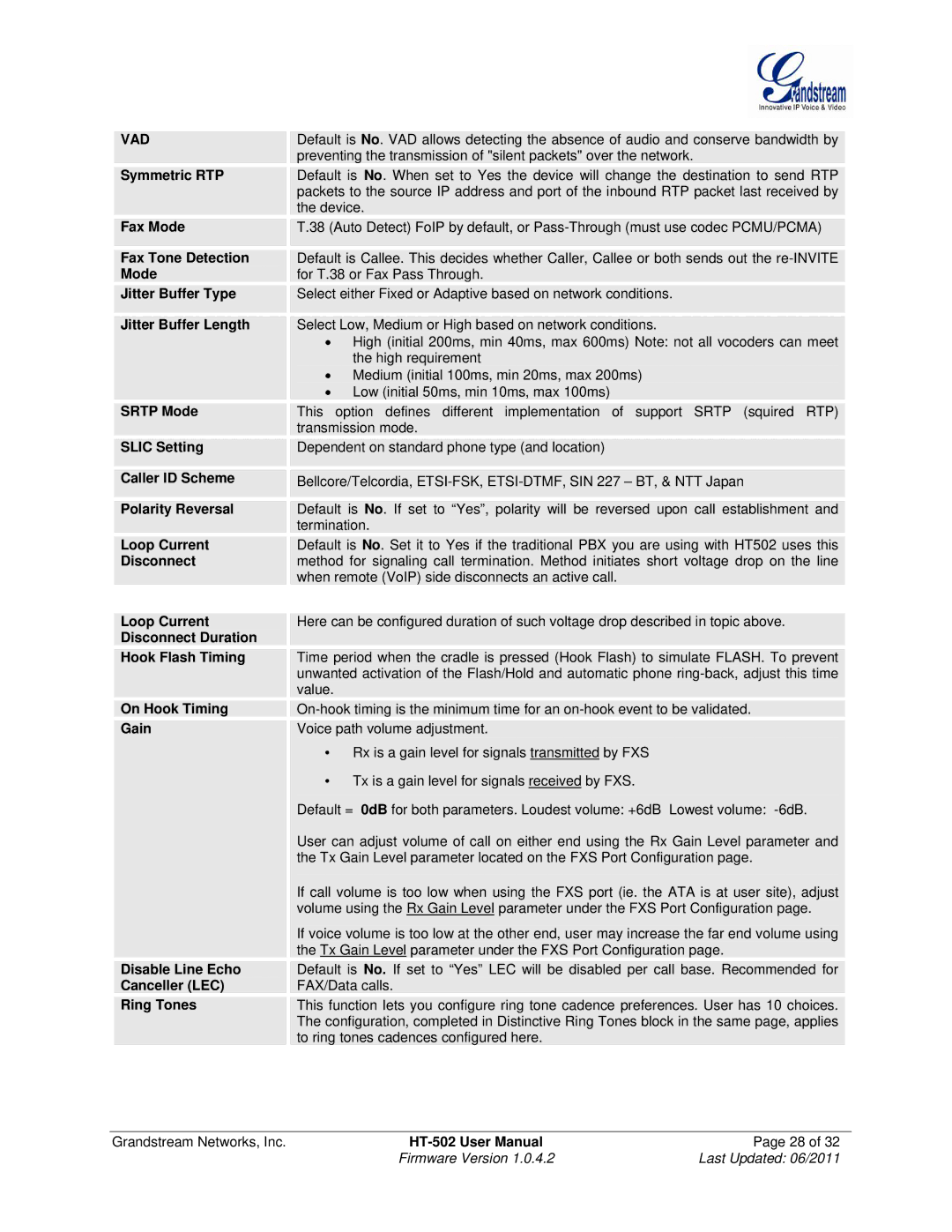
| VAD |
| Default is No. VAD allows detecting the absence of audio and conserve bandwidth by |
|
|
|
| preventing the transmission of "silent packets" over the network. |
|
|
|
|
|
|
| Symmetric RTP |
| Default is No. When set to Yes the device will change the destination to send RTP |
|
|
|
| packets to the source IP address and port of the inbound RTP packet last received by |
|
|
|
| the device. |
|
|
|
|
|
|
| Fax Mode |
| T.38 (Auto Detect) FoIP by default, or |
|
|
|
|
|
|
|
|
|
|
|
| Fax Tone Detection |
| Default is Callee. This decides whether Caller, Callee or both sends out the |
|
| Mode |
| for T.38 or Fax Pass Through. |
|
|
|
|
|
|
| Jitter Buffer Type |
| Select either Fixed or Adaptive based on network conditions. |
|
|
|
|
|
|
|
|
|
|
|
| Jitter Buffer Length |
| Select Low, Medium or High based on network conditions. |
|
|
|
| • High (initial 200ms, min 40ms, max 600ms) Note: not all vocoders can meet |
|
|
|
| the high requirement |
|
|
|
| • Medium (initial 100ms, min 20ms, max 200ms) |
|
|
|
| • Low (initial 50ms, min 10ms, max 100ms) |
|
|
|
|
|
|
| SRTP Mode |
| This option defines different implementation of support SRTP (squired RTP) |
|
|
|
| transmission mode. |
|
|
|
|
|
|
| SLIC Setting |
| Dependent on standard phone type (and location) |
|
|
|
|
|
|
|
|
|
|
|
| Caller ID Scheme |
| Bellcore/Telcordia, |
|
|
|
|
|
|
|
|
|
|
|
| Polarity Reversal |
| Default is No. If set to “Yes”, polarity will be reversed upon call establishment and |
|
|
|
| termination. |
|
|
|
|
|
|
| Loop Current |
| Default is No. Set it to Yes if the traditional PBX you are using with HT502 uses this |
|
| Disconnect |
| method for signaling call termination. Method initiates short voltage drop on the line |
|
|
|
| when remote (VoIP) side disconnects an active call. |
|
|
|
|
|
|
| Loop Current |
| Here can be configured duration of such voltage drop described in topic above. |
|
| Disconnect Duration |
|
|
|
|
|
|
|
|
| Hook Flash Timing |
| Time period when the cradle is pressed (Hook Flash) to simulate FLASH. To prevent |
|
|
|
| unwanted activation of the Flash/Hold and automatic phone |
|
|
|
| value. |
|
|
|
|
|
|
| On Hook Timing |
|
| |
|
|
|
|
|
| Gain |
| Voice path volume adjustment. |
|
|
|
| • Rx is a gain level for signals transmitted by FXS |
|
|
|
| • Tx is a gain level for signals received by FXS. |
|
|
|
| Default = 0dB for both parameters. Loudest volume: +6dB Lowest volume: |
|
|
|
| User can adjust volume of call on either end using the Rx Gain Level parameter and |
|
|
|
| the Tx Gain Level parameter located on the FXS Port Configuration page. |
|
|
|
| If call volume is too low when using the FXS port (ie. the ATA is at user site), adjust |
|
|
|
| volume using the Rx Gain Level parameter under the FXS Port Configuration page. |
|
|
|
| If voice volume is too low at the other end, user may increase the far end volume using |
|
|
|
| the Tx Gain Level parameter under the FXS Port Configuration page. |
|
|
|
|
|
|
| Disable Line Echo |
| Default is No. If set to “Yes” LEC will be disabled per call base. Recommended for |
|
| Canceller (LEC) |
| FAX/Data calls. |
|
|
|
|
|
|
| Ring Tones |
| This function lets you configure ring tone cadence preferences. User has 10 choices. |
|
|
|
| The configuration, completed in Distinctive Ring Tones block in the same page, applies |
|
|
|
| to ring tones cadences configured here. |
|
Grandstream Networks, Inc. | Page 28 of 32 | |
| Firmware Version 1.0.4.2 | Last Updated: 06/2011 |
